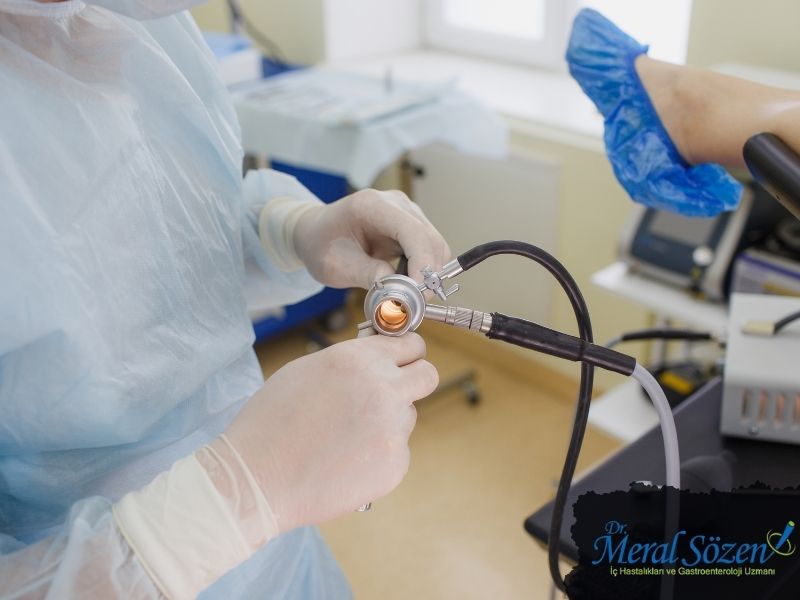Kolonoskopi Ankara; bağırsak hastalıklarının tanısında, kolon ve rektum kanseri taramalarında uygulanan bir teşhis yöntemidir. Ucunda kamera bulunan kolonoskop cihazı yaklaşık bir parmak kalınlığındadır ve bükülebilen bir yapısı vardır. Makat yolu ile gönderilen kolonoskop cihazı ile görüntülemenin yanı sıra ilgili bölgeden parça da alınabilmektedir.
Kolonoskopi Nedir?
Kolonoskopi Ankara; bağırsak ve rektumda yaşanan şikayetlerin nedenlerinin araştırılmasında başvurulan endoskopik bir işlemdir ve bu işlem için gastroenteroloji doktoruna başvurulması gerekmektedir. Kolonoskopi işlemi ile nitelikli tanı konulabilmesi ve işlem sırasında yaşanabilecek komplikasyonların önüne geçilmesi amacı ile alanında tecrübeli bir hekime başvurulmalıdır. Hekiminiz hali hazırda bulunan hastalıklarınız ve kullandığınız ilaçları değerlendirecek; işlemden birkaç gün öncesinde nelere dikkat etmeniz konusunda uyarılarda bulunacaktır.
Kolonoskopi Neden Yapılır?
Kolonoskopi işlemi genellikle bağırsakta yaşanan şikayetler doğrultusunda tanı amacı ile uygulanmaktadır. Aşağıdaki şikayetlerin yaşanması durumunda hekiminiz kolonoskopi incelemesine ihtiyaç duyabilmektedir;
- Tekrarlayan ishal
- Rektal kanama
- Kronik karın ağrısı
- Kronik kabızlık
- Kontrol altında alınamayan demir eksikliği ve kansızlık
- Spor ve diyet yapılmadığı halde kilo kaybı yaşanması
Kolonoskopi işlemi aynı zamanda bağırsak kanseri taramasında da altın standart haline gelmiştir. 50 yaş üzeri kişilerde kolon ve rektum kanserinin erken tanısı amacı ile her 5 yılda bir kolonoskopi incelemesi önerilmektedir. Risk taşıyan kişilerde ise bu süre daha sıklaşabilmektedir. Kanser hastalığının yanı sıra polip şikayetinin varlığında da kolonoskopi incelemesine ihtiyaç duyulmaktadır.

Kolonoskopi Nasıl Yapılır?
Kolonoskopi işlemi öncesinde hekiminiz birtakım talimatlara uymanızı isteyecektir. İşlemden birkaç gün öncesinde yumuşak ve sıvı gıdalar tüketilmeli ve bağırsak temizliği amacı ile önerilen müshil ilacı işlemden önce kullanılmalıdır. İşlem öncesinde hastanın aç olması, kan sulandırıcı ilaç ve aspirin kullanmaması gerekmektedir. İşlem sırasında hastanın iki bacağı göğse çekilmiş bir şekilde sol tarafına uzanması istenmektedir. Bu süreçte gerektiği durumlarda anestezi işlemi de uygulanabilmektedir. Hasta uyutulduktan sonra kolonoskop cihazı makat yolu ile bağırsaklara gönderilmektedir. İnce bağırsak, kalın bağırsak ve bu şekilde kolonoskop cihazının ucundaki kamera yardımı ile incelenebilmektedir.
İlgili bölgelerde polip bulunuyorsa işlem sırasında çıkarılabilmekte ya da biyopsi işlemi de gerçekleştirilebilmektedir. İşlem tamamlandıktan sonra hastanın ayılması beklenmektedir. Hasta işlemden sonra evinde istirahat edebilmektedir. İşlem günü araç kullanmaması, işe dönülmemesi önerilmektedir.
Kolonoskopi Ne Kadar Sürer?
Kolonoskopi işlemi yaklaşık 30 ila 60 dakika arasında sürmektedir. Bu süreçte hasta uyutulmakta, işlem gerçekleştirilmekte ve hastanın ayılması bulunmaktadır.
Ankara Kolonoskopi Doktoru Tavsiye
Ankara kolonoskopi doktoru tavsiyesi bağırsak problemi yaşayan pek çok kişinin aradığı bir konudur. Kolonoskopi işlemi her girişimsel yöntemde olduğu gibi birtakım riskler taşımaktadır. Bu nedenle bu işlem için sağlık merkezi ve işlemi gerçekleştirecek olan doktor seçiminde özenli davranılması gerekmektedir.
Kolonoskopi işlemi; kanama, enfeksiyon, bağırsak duvarının zedelenmesi gibi risk faktörlerinin önüne geçilebilmesi amacı ile doktor seçimi oldukça önemlidir.
Ankara Kolonoskopi Fiyatları
Ankara Kolonoskopi fiyatları; işlemin uygulanacağı merkeze, işlemi uygulayacak olan hekime ve işlemin hangi amaçla gerçekleştirileceğine bağlı olarak değişkenlik göstermektedir.





